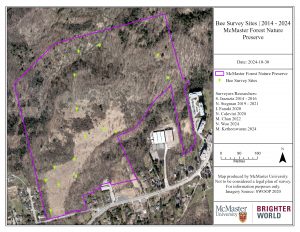The final stop on the Bee Trail is located at the McMaster Forest Nature Preserve and includes five bee homes were installed in October 2021. This installation was carried out by the SUSTAIN 3S03 team in collaboration with Facility Services. The choice of McMaster Forest as a site for these homes was strategic; this area boasts a rich diversity of ecosystems, including forests, prairies, and meadows. Such varied environments are critical for supporting over 200 bee species and a multitude of other wildlife year-round. The presence of these bee homes enhances the ecological integrity of the forest, providing vital nesting sites for native bees and fostering a healthy habitat that promotes biodiversity.
Active pollinator research is being conducted on the property by the McMaster Native Bee Lab under Dr. Susan Dudley in the Department of Biology.

Fun Fact: Leaf-cutter bees (Megachile spp.) are creative builders that use cut pieces of leaves to construct their nests, often found in hollowed out tree and shrub branches. (1)
Species Highlight:
Local Native Bee Spotlight: The Eastern Snail Shell Mason Bee (Osmia conjuncta) is a unique local species of mason bee found in our area and is the only bee in Canada to make use of snail shells for nesting!
References:
- Pollinator Facts [Internet]. Pollinator Partnership Canada. Available from: https://pollinatorpartnership.ca/en/pollinator-facts
